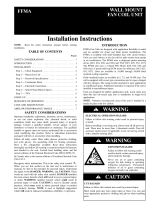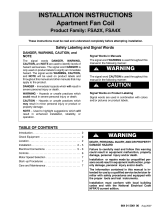Page is loading ...

This kit is designed to allow passage of high and low
voltage wiring connections through the unit bottom pan
on all (*)P4SM Series units.
!
WARNING:
This kit is to be installed by a qualified service
technician in accordance with these instructions
and all codes having jurisdiction. Failure to follow
these instructions could result in serious injury,
property damage, or death.
!
WARNING:
All electrical wiring must comply with the latest
edition of the National Electrical Code ANSI/
NFPA 70.
Bottom Power Entry Kit
Installation Instructions
These instructions are primarily intended to assist
qualified individuals experienced in the proper installa-
tion of this appliance. Some local codes require
licensed installation/service personnel for this type of
equipment.
This Kit Includes:
1 – Bottom Power Service Box
1– Bottom Power Service Box Cover
1– Length of 3/4” flexible conduit
1– Extra Parts Package which includes:
8 - #10 x 1/2” sheet metal screws
2 - 3/4” flexible conduit connectors
1 - 2” X 6” RSC Pipe w/fittings
2 - 2” X 1” Knockout reducer bushings
1 - Installation instruction sheet
Installation:
1. Remove the field wiring compartment and blower
compartment access panels.
2. Remove the knockout covers located at the bot-
tom of the service disconnect mounting panel and
interior heat exchanger/ blower divider panel.
(*)P4SM Model Series Accessory
7.5/10 Ton Packaged A/C Units
3. Remove the power service box mounting plate
located below the blower assembly and route field
wiring through bottom of unit. 7/8" knockouts are
provided for high and low voltage counduit con-
nections. Holes may be punched larger as re-
quired. Make proper connections to mounting
plate and secure back in place.
4. Attach the bottom power service box to the mount-
ing plate with four screws provided in the extra
parts package.
5. Secure the 2” x 6” RSC nipple evenly between the
right side service box and Blower/Heat Exchanger
divider panel knockouts using the 2” locknuts pro-
vided. (One each end.) Cap using the 2” insulating
bushings to avoid wire abrasion.
6. Route flexible conduit through 7/8” diameter hole
provided in divider panel. Install one 7/8” insulat-
ing bushing and flexible connector on each end of
conduit. Complete assembly by attaching one
end to the low voltage knockout on the left side of
the service box and the other end to the rear of the
low voltage field wiring panel. Secure using lock-
nuts provided.
7. Complete high voltage side wiring requirements
by installing appropriate field supplied fittings
and conduit from service disconnect to conduit
knockout provided at bottom of unit end panel.
Note: Kits are shipped with two 2” x 1” conduit
knockout reducer bushings for units requiring
smaller gage field wire. Other (field supplied)
reducers are approved for use to meet specific
conduit size requirements.
8. Route high voltage wiring through 2” conduit
and out through field supplied connections to
disconnect. Make all appropriate connections.
9. Route low voltage wiring from bottom power
service box, through flexible conduit, and into
the low voltage control panel. Make all appro-
priate connections.
10. Check all wiring and conduit connections and
tighten as required.
11. Attach service box cover using the remaining four
screws provided.
12.Caulk around area where conduit passes
through interior divider panel to ensure an air/
water tight seal.
13. Replace all panels.

7079600
Specifications & illustrations subject to change without notice or incurring obligations (06/15).
O’Fallon, MO, © Nortek Global HVAC LLC 2015. All Rights Reserved.
Figure 1. (*)P4SM Bottom Power Entry Kit
Bottom
Power
Box
High
Voltage
Connections
Bottom
Power Box
Cover
Low
Voltage
Connections
Low
Voltage
Box
Control
Panel
Disconnect, Conduit,
and Connectors
(Field Supplied)
3/4" Flexible
Conduit
2" x 6"
Conduit
Pipe
/


